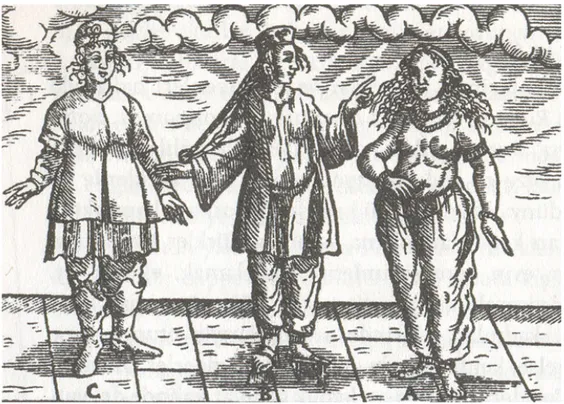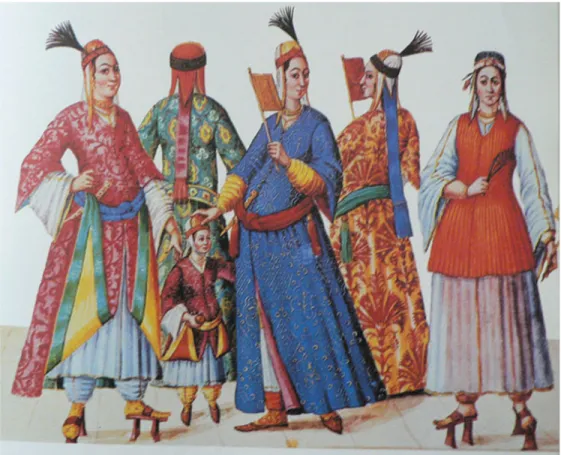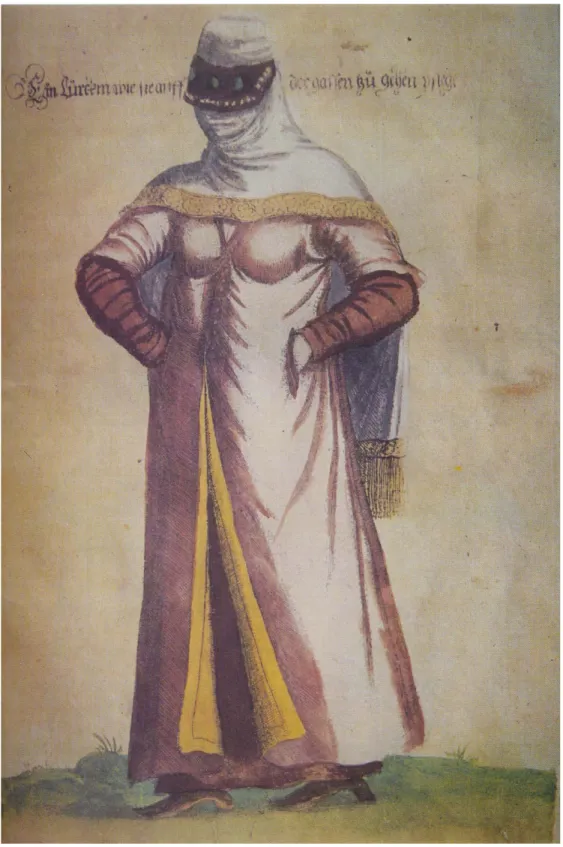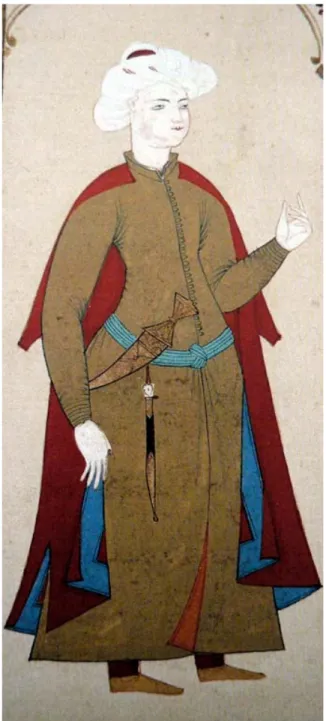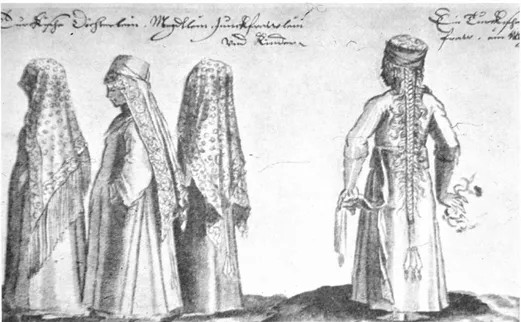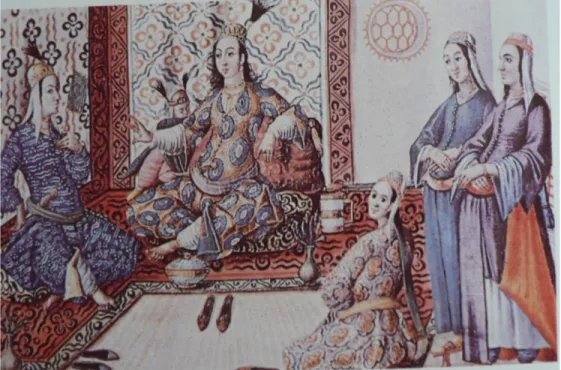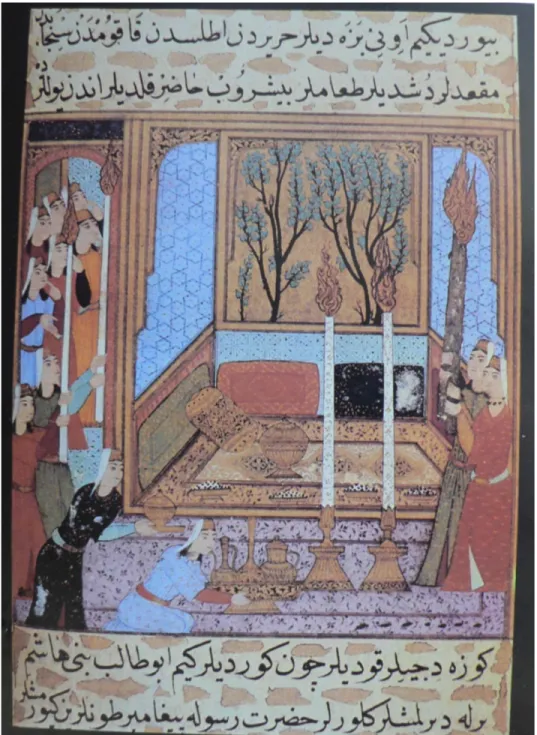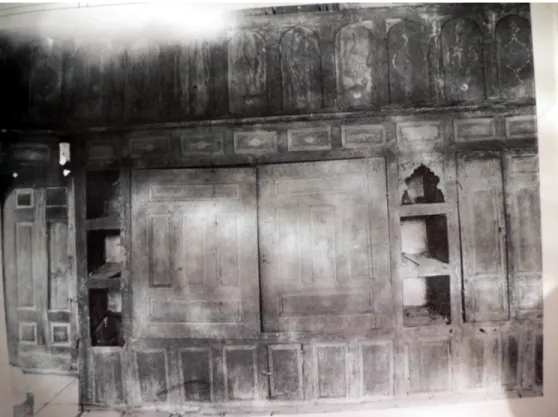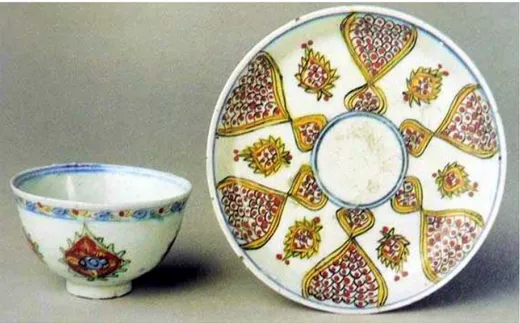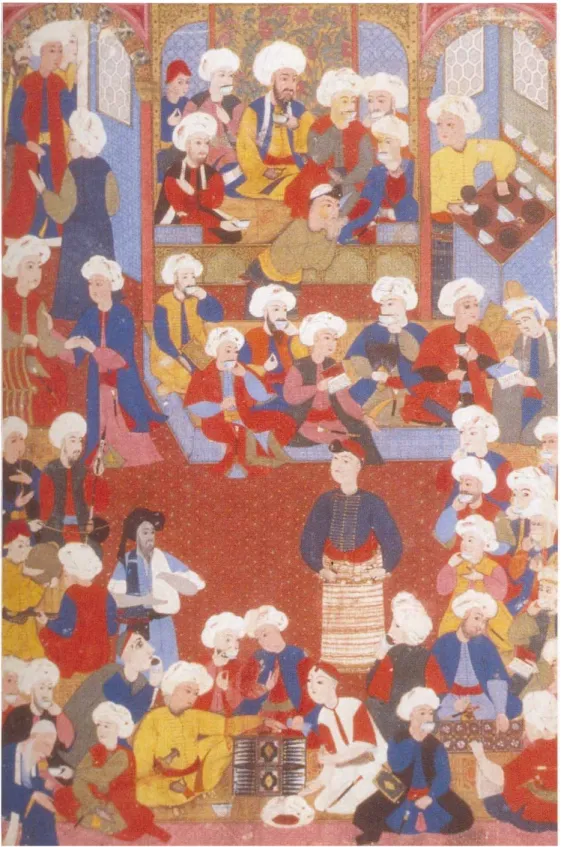ORIGINS OF A CONSUMER CULTURE
IN AN EARLY MODERN CONTEXT: OTTOMAN BURSA
A Ph.D. Dissertation by EMİNEGÜL KARABABA Department of Management Bilkent University Ankara June 2006
ORIGINS OF A CONSUMER CULTURE
IN AN EARLY MODERN CONTEXT: OTTOMAN BURSA
The Institute of Economics and Social Sciences of
Bilkent University
By
EMİNEGÜL KARABABA
In Partial Fulfilment of the Requirements for the Degree of DOCTOR OF PHILOSOPHY
in
THE DEPARTMENT OF MANAGEMENT BILKENT UNIVERSTIY
ANKARA
I certify that I have read this thesis and have found that it is fully adequate, in scope and in quality, as a thesis for the degree of Doctor of Philosophy in Business Administration.
--- Professor Güliz Ger
Supervisor
I certify that I have read this thesis and have found that it is fully adequate, in scope and in quality, as a thesis for the degree of Doctor of Philosophy in Business Administration.
---
Assistant Professor Özlem Sandıkcı Examining Committee
I certify that I have read this thesis and have found that it is fully adequate, in scope and in quality, as a thesis for the degree of Doctor of Philosophy in Business Administration.
---
Assistant Professor Mehmet Kalpaklı Examining Committee
I certify that I have read this thesis and have found that it is fully adequate, in scope and in quality, as a thesis for the degree of Doctor of Philosophy in Business Administration.
--- Assistant Professor Ahmet Ekici Examining Committee
I certify that I have read this thesis and have found that it is fully adequate, in scope and in quality, as a thesis for the degree of Doctor of Philosophy in Business Administration.
--- Professor Selami Sargut Examining Committee
Approval of the Institute of Economics and Social Sciences
--- Professor Erdal Erel
ABSTRACT
ORIGINS OF A CONSUMER CULTURE
IN AN EARLY MODERN CONTEXT: OTTOMAN BURSA
Karababa, Eminegül Ph.D., Department of Management
Supervisor: Prof. Dr. Güliz Ger
June, 2006
Studies on the origins of the modern consumer culture generally focus on the early modern western context with the inherent assumption that today’s modern consumer culture had its origins in the early modern west. This study examines origins of an early modern consumer culture in a non-western context; Ottoman Empire between the mid-sixteenth to mid-seventeenth centuries and investigates how particularities of the context shaped a different consumer culture. Specifically the study focuses the town of Bursa. In the Ottoman context, social structure provided differences from the previously theorized western contexts concerning consumer culture phenomena. Ottoman context had a different dominant class and relatively high level of upward mobility among the ranks. Ottoman dominant class allowed the entry of lowest echelons and had intergenerational downward mobility. Multiple data sources including archival data were used to conduct this historical research. Quantitative and qualitative data analysis techniques were complemented. Findings show that indeed an early modern consumer culture in a non-western context existed. In addition, the characteristics of the Ottoman social structure shaped a different Ottoman consumer culture both in terms of appropriation of different categories of goods and the processes of fashion and diffusion of goods.
Key words: Consumer culture, fashion, social structure, multiple modernities, Ottoman Period, leisure activities, luxury, Bursa, clothing, home furnishing, coffeehouse, bath.
ÖZET
ERKEN MODERN ORTAMDA BİR TÜKETİM KÜLTÜRÜNÜN ORTAYA ÇIKIŞI: OSMANLI BURSASI
Karababa, Eminegül Doktora, İşletme Bölümü Tez Yöneticisi: Prof. Dr. Güliz Ger
Haziran, 2006
Modern tüketim kültürünün ortaya çıkışı üzerine yapılan çalışmalar, genellikle modern tüketim kültürünün batı menşeili olduğu varsayımından yola çıkarak, erken modern batılı toplumları incelemişlerdir. Bu çalışmada, erken modern bir tüketim kültürünün ortaya çıkışı, batılı olmayan bir ortamda, yani onaltıncı yüzyıl ortalarıyla onyedinci yüzyıl ortaları arasındaki Osmanlı bağlamında incelenmiştir. Bunun yanısıra, Osmanlı ortamının kendine özgü özelliklerinin nasıl farklı bir tüketim kültürünün varlığına yol açtığı da çalışılmıştır. Bu araştırmanın odağı dönemin Bursa şehri seçilmiştir. Osmanlı toplum yapısı, daha önce çalışılan örneklerden farklıdır. İngiltere, Fransa, ve ABD örneklerine göre, Osmanlı toplumu değişik hakim sınıf özellikleri ve göreceli olarak daha yüksek seviyede bir yukarı sosyal hareketlilik göstermektedir. Osmanlı hakim sınıfı, en alt sınıfların dahi hakim sınıfa girişine izin tanıdığı gibi, hakim sinif üyelerinin nesiller arası bir aşağı hareketliliğine de izin vermektedir. Bu çalışmada arşiv kaynakları da dahil olmak üzere farklı veri kaynakları kullanılmıştır. Kantitatif ve kalitatif veri analiz yöntemleri, bir birlerini tamamlayacak şekilde uygulanmıştır. Araştırmanın bulguları, erken modern bir tüketim kültürünün, batılı olmayan bir ortamda da bulunabildiğini göstermiştir. Bunun yanısıra, Osmanlı sosyal yapısının kendine has özellikleri, değişik meta kategorilerinin kabul görmesi ile farklı moda ve meta yayılım süreçlerinin oluşmasını sağlamıştır.
Anahtar Kelimeler: Tüketim kültürü, moda, sosyal yapı, çoğul moderniteler, Osmanlı dönemi, boş vakit tüketimi, lüks tüketim, Bursa, giyim, ev eşyası, kahvehane, hamam.
ACKNOWLEDGMENTS
I would like to express my sincere appreciation to my supervisor, Güliz Ger, whose intellectual personality, expertise, insight, and patience added considerably to my graduate experience. It will be impossible for me to complete such a challenging thesis without her trust in me and my capabilities. Mehmet Kalpkalı supported me with his advices and guidance, especially during when I was desperate about my research. He shared his invaluable knowledge and resources. I doubt that I will ever be able to convey my appreciation fully, but I owe him my eternal gratitude. I would like to thank Özlem Sandıkcı for her noteworthy comments and critiques that helped me develop my arguments. Also, I am thankful to the other members of my thesis committee, Ahmet Ekici and Selami Sargut.
I would like to indicate my gratitude to Halil İnalcık for his guidance, and advices which were essential to the completion of this dissertation. He thought me innumerable lessons on the workings of academic research in general. I am very grateful to Oktay Özel for spending his precious time checking transcriptions of my probate data. I would like to thank Yusuf Oğuzoğlu who introduced me Bursa and provided me direction.
A very special thanks goes out to Güler İlkuçan who welcomed me to her house in Bursa and provided me kind hospitality. I am thankful to Altan İlkuçan whom I benefited so much from his insight and valuable assistance in various stages of this thesis. The friendship of Baskın Yenicioğlu, Eser Arısoy, Berna Tarı, Erim Ergene, Şahver Ömeraki, and Ayça İlkuçan is much appreciated. I would also like to thank my family for the support they provided me through my entire life. Without their love and encouragement, I would not have finished this thesis.
TABLE OF CONTENTS
ABSTRACT ...iv
ÖZET ...v
ACKNOWLEDGMENTS ...vi
TABLE OF CONTENTS ...vii
CHAPTER I: INTRODUCTION ...1
CHAPTER II: THEORETICAL BACKGROUND ………...8
2.1 Origins and Defining Characteristics of Modern Consumer Culture………...9
2.2 Social Structure and Consumer Culture ...16
2.3 Motivation for Study ...24
CHAPTER III: COMPARATIVE CONTEXT...27
3.1 Comparison of Demographic Sphere...28
3.2 Comparison of Economic Sphere and Market Transformations...33
3.3 Comparison of Political Sphere...42
3.4 Comparison of Cultural Sphere………..46
3.5 Comparison of Social Sphere……….53
3.6 Period of Study………..61
3.7 Focus of Study: Bursa………62
CHAPTER IV: METHODOLOGY…………...63
4.1 Data Sources………..65
4.1.1 Governmental Data Sources………...66
4.1.2 Literary Data Sources……….70
4.1.5 Secondary Data Sources………..73
4.2 Data Analysis……….……73
4.2.1 Quantitative Data Analysis………...74
4.2.1.1 ANOVA ……….76
4.2.1.2 Non-parametric tests………..77
4.2.2 Qualitative Data Analysis……….………..80
4.3 Limitations of the Methodology………82
CHAPTER V: CONSUMPTION OF CLOTHING ...83
5.1 Spread of Clothing Items throughout Ottoman Society…………....86
5.2 Interest of the Ottoman Individual in the Acquisition of Clothing……….……89
5.3 Spread of Luxury Clothing……….90
5.4 Commercialization of Clothing Fashion……… 97
5.4.1 In-and-Out of Fashion………97
5.4.2 Movement of Fashion………...99
5.4.3 Impact of Institutions on the Commercialization of Fashion…102 CHAPTER VI: CONSUMPTION OF HOME FURNISHING AND HOME TEXTILES...107
6.1 The Spread of Home furnishing and Home textiles……….108
6.2 Interest of the Ottoman Individual in the Acquisition of Home-Furnishing and Home-Textiles………..110
6.3 The Spread of Luxury Home Furnishing Goods………..112
6.4 Commercialization of Home Furnishing and Home Textiles Fashion……….115
CHAPTER VII: COMMERCIALIZATION OF LEISURE TIME ACTIVITIES……...120
7.1 Coffee and Coffeehouse Consumption of Ottoman Men …………121
7.1.1 Spread of Coffee and Coffeehouse Consumption………….121
7.1.2 Tastes in Coffeehouse Consumption ………...125
7.1.3 Genealogy of Coffee and Coffeehouse Consumption……...128
7.2 Bath Consumption………...134
7.2.1 Spread of Bath Objects………..137
7.2.3 Commercialization of Bathhouse Fashion……….141
7.2.4 Impact of Institutions on Bathhouse Consumption………...142
CHAPTER VIII: CONCLUSION………146
8.1 Early Modern Consumer Culture in a non-Western Context……..147
8.2 Modernization Tendencies………..150
8.3 The Ottoman Social Structure and Consumer Culture……….153
8.3.1 Three Trickling Processes……….153
8.3.2 Appropriation of Categories of Goods………..156
8.4 Limitations and Future Research...157
LIST OF TABLES
3.1: Summary of Comparative Context……….……182
.
3.2: The results of ANOVA test of Log (Wealth) Data………….……184 4.1: The archive numbers and dates of four probate books…………...185 4.2: Number of probate records analyzed in each period,
for each class and for each gender……….….185
4.3: The CPI values ……….…..186
4.4: Test of normality assumption for wealth distribution………….…186 4.5: Test of homogeneity of variances for wealth distribution………..186
4.6: List of words and things……….187
5.1: Results of Chi-square test for differences between Period 1 and Period 2 in the number of people who
possessed a certain clothing item………...189 5.2: Results of Chi-square test for differences between
Period 1 and Period 2 in the number of people who possessed a certain clothing item for the askeri and
beledi classes separately……….191 5.3: Results of the Mann-Whitney U test for Differences
between Period 1 and Period 2 in the number of
a certain dress item possessed per woman………..193 5.4: Results of the Mann-Whitney U test for differences
between Period 1 and Period 2 in the number of a certain dress item possessed per woman for the
askeri and beledi classes separately………...194 5.5: Results of the Mann-Whitney U test for differences
between Period 1 and Period 2 in the number
5.6: Results of the Mann-Whitney U test for differences between Period 1 and Period 2 in the number of a certain dress item possessed per man for the askeri
and beledi classes separately………...196 5.7: Results of Chi-Square test for differences between
the askeri and beledi classes in the number of women who possessed a certain clothing item in the
first period and second periods separately………..197 5.8: Results of Chi-Square test for differences between
the askeri and beledi classes in the number of men who possessed a certain clothing item in the first period and
second periods separately……….198 6.1: Results of Chi-square test for differences between Period 1
and Period 2 in the number of people who possessed
a certain home furnishing or home textiles item ……….199 6.2: Results of Chi-square test for differences between Period 1
and Period 2 in the number of people who possessed a certain certain home furnishing or home textiles item
for the askeri and beledi classes separately……….200 6.3: Results of the Mann-Whitney U test for Differences
between Period 1 and Period 2 in the number of a certain
home furnishing or textile item possessed per person……….201 6.4: Results of the Mann-Whitney U test for differences
between Period 1 and Period 2 in the number of a certain home furnishing or textiles item possessed per person for
the askeri and beledi classes separately………202 6.5: Results of Chi-Square test for differences between
the askeri and beledi classes in the number of people who possessed a certain home furnishing or textiles
in the first period and second periods separately………..203 7.1: Results of Chi-square test for differences between Period 1
and Period 2 in the number of men who possessed a certain
coffee utensil………..204 7.2: Results of Chi-square test for differences between Period 1
and Period 2 in the number of men who possessed a coffee
utensil separately for askeri and beledi classes……….205 7.3 Results of Chi-square test for differences between
7.4: Results of Chi-square test for differences between Period 1 and Period 2 in the number of women who possessed a
certain a bath object for the askeri and beledi classes separately…….207 7.5 Results of Chi-Square test for differences between the
askeri and beledi classes in the number of women who
possessed a certain bath object in the first period
LIST OF FIGURES
5.1 Depiction of Ottoman women’s style of dress by
the sixteenth-century traveler Solomon Schweigger………… …….169
5.2 Styles of dress of five women from the Ottoman court (sixteenth century)……… ....170
5.3 Outwear (Dolama) of an Ottoman woman (sixteenth century)… ….171 5.4 Style of dress of a rich Ottoman man (seventeenth century)…….…172
5.5 Three women with their outerwear and another woman with saçbağı (hair accessory)……….……173
6.1 A view from Palace………...…….174
6.2 An illustration of a wealthy Ottoman home……… ……..175
6.3 Wooden Cupboards……… ………176
7.1 Coffee cup produced in Kütahya……… ………177
7.2 A late sixteenth century coffee house……… ……….178
7.3 A group of women going to a public bath……… ………..179
7.4 A women depicted in the bath……… ……....180
7.5 Mistress and servant going to a public bath………181
CHAPTER I
INTRODUCTION
Studies on the origins of current consumer culture generally focus on the early modern western context with the argument that the modern consumer culture had its origins in the west (Berry, 1994; Brewer and Porter, 1993, McKendrick et al, 1982; Mukerji, 1983; Roche, 2000; Schama, 1987; Shammas, 1990; Veblen, [1899] 1994; Weatherill, 1988). An implicit assumption appears to be the development and spread of this western-originated consumer culture throughout the globe in contemporary times. However, recent literature on consumption studies suggests that today multiple modern consumer cultures have been forming throughout the globe (Belk, Ger and Askegaard, 2003; Ger and Belk, 1999; Howes, 1996; Miller, 1995; Venkatesh, 1995; Zhou and Belk, 2004). To be able to understand multiple modernities and multiple modern consumer cultures, their specific early modern histories have to be studied because each culture produces its own institutional formations and cultural foundations (Wittrock, 1998). In this dissertation, I explore if an early modern consumer culture in a non-western context existed and develop a
theoretical understanding according to the particularities of the context. I examined early modern Ottoman consumer culture and investigated how Ottoman social structure shaped a different consumer culture.
The character of social structure is dependent on factors such as the nature of dominant class (its composition and penetrability), the type of mobility (group / individual and upward / downward), and the level of intensity and generality of mobility that define the rigidity of social structure (Sorokin, 1959). Ottoman social structure is different than the ones studied in terms of high level of penetrability of dominant class, which allowed not only upward but downward mobility as well, presence of intense and general individual mobility, and occurrence of group mobility, which did not create a rival class against the dominant class, such as the newly rich in the European counterparts (Andrews and Kalpaklı, 2005; İnalcık, 1969; İnalcık, 1997; Kunt, 1983; Goffman, 2004). First, unlike European societies, there was not landowning nobility that defines a dominant class according to family lineage. Bureaucrats, military people, and the professors of theological schools constituted the dominant class. The members of the dominant class was formed such that, either state gathered children from peasantry and educated them to assign high level positions or young peasantry moved to small towns to get higher education in order to find jobs in the state. Moreover, the status and wealth attained by these people could not pass to the next generation and there was intergenerational downward mobility from dominant class. Therefore dominant class was penetrable because it is open to intense and general upward and downward individual mobility. Moreover, another type of individual upward mobility was among the peasant population who moved to cities to find jobs in the wakf institutions. Lastly, the
their wealth. The boundaries between merchants and the elite blurred (Andrews and Kalpaklı, 2005). These show that Ottoman social structure was less rigid than the European ones.
Although, both the field of consumption studies and the studies regarding the origins of consumer culture discuss the relation between social structure and consumption (Bourdieu, 1989; Douglas and Isherwood, 1996; Holt, 1998; Levy, 1981; McKendrick, 1982; Mukerji, 1983; Roche, 2000; Simmel, [1904] 1957; Schama, 1987; Veblen, [1889] 1994; Weber, 1978), they either focus on similar social structures or do not provide an explanation concerning the characteristics of social structure in relation to consumption. Bourdieu (1989), Simmel ([1904] 1957), Mukerji (1983), Roche, 2000, and Veblen ([1899] 1994) study social structures, which dominant classes are relatively impenetrable and composed of either nobility or members who possess high level inherited cultural capital (which is not possible to established when there is downward intergenerational mobility as in the Ottoman case). Simmel ([1904] 1957), Mukerji (1983), and Veblen ([1899] 1994) examine contexts of upward group mobility, where a powerful newly rich class formed and competed against the dominant class. Levy (1978) and Holt (1998) analyze American society, where dominant class is penetrable and there is intense and general individual upward mobility. However, they do not consider the impact of nature of social class to consumption.
In this study, I investigate two groups of research questions. The first group is concerned with determining whether an early modern consumer culture in a non-western context actually existed. The second group of research questions relates to the particularities of the Ottoman context, which distinguishes that context from the West and provides me with the opportunity to generate a theoretical contribution.
Throughout the study, I place my emphasis on the characteristics of Ottoman social structure as a particularity of the context.
Early modern Ottoman society is enlightening to study in this regard, because it was different from the Western context in terms of both the governing ethics and the social structure. Islamic ethics (the way experienced in the Ottoman context) shaped the Ottoman consumer, enjoined appropriate ways of consumption, and guided the state and market actors such as the guilds and the wakfs (religious
foundations established by the military class, local merchants, other capital owners, and provincial elites as a kind of philanthropic activity). The penetrable Ottoman dominant class and presence of group and individual upward mobility within Ottoman society influenced the spread of consumer goods throughout the society, formation of class taste, fashion process, and luxury consumption. Within the Ottoman context, I utilized the city of Bursa as the focus of the study because it was an urban center with high mobility, the last entrepot on the Silk Road, a principal center of textile production, and had always been a cultural center. In an urban context like this, with a dynamic demographic, economic, social, and cultural structure, the possibility of observing a consumer culture is high.
The method of this study is unique in the sense that it utilizes both quantitative and qualitative methods in historical research conducted in the field of marketing. I triangulated both the data sources and the analysis techniques. My primary data sources can be grouped into three categories: governmental records, literary sources, and visual sources and artifacts. The governmental data sources were probate inventories (tereke defterleri), price books issued by the Ottoman state (narh), formal opinions of religious authority (fetva), the codes issued by the
Literary sources included poetry (court and folk), travelers’ accounts, chronicles, books on morality, good-manner books, and surname literature. The visual sources were pictures and miniatures. In addition, I employed some artifacts dating back to the period to visualize objects.
I transcribed three hundred sixty-four probate inventories which were recorded in Bursa judicial courts and categorized the goods listed. In the study I focused on clothing, home furnishing, coffeehouse, and bath consumption because these categories reflect the existence of indicators of consumer culture (mentioned in the first part of research questions). Non-parametric statistical analysis techniques – chi-square and Mann Whitney U Tests – were conducted to compare the possessions of the askeri (ruling) and beledi (ruled) classes between two periods (the mid-sixteenth and mid-seventeenth centuries). Analysis of probate data records provided the framework of this research. I then used my findings from the other data sources to complement the findings from the probate data, and compared what the two had to say about consumption in early modern Ottoman society. I also conducted content and discourse analysis of the literary data and visual analysis of the visual data.
My findings indicate that an early modern Ottoman consumer culture existed during the mid-sixteenth and mid-seventeenth centuries. Clothing items, home furnishing items, coffeehouse utensils, and bath objects were analyzed. Moreover, coffeehouses and baths were studied as sites for leisure consumption. In the case of certain items I observed the indicators of a consumer culture: spread of such items throughout the population, increase in interest in the acquisition of goods, spread of luxury consumption and commercialization of fashion items, as well as of coffeehouses and public baths. This study contributes to the field of consumption studies as a challenge to the convergence theory, which assumes that only one
modern consumer culture is experienced throughout the globe, and that it originated in the west.
Moreover, in the course of the analysis, my focus is on the particularities of the context. The impact of ethics and institutional structure on consumer culture showed that a modernization tendency was present in the Ottoman context during the sixteenth and seventeenth centuries. My findings show that there was a disparity between ethical principles and actual consumption practices. Also, traditional codes regarding standards of production and quality were negotiated between the state and the guilds, which led to the production of populuxe and fashion goods. At the heart of these changes, was a transformation from the traditional order which had been kept stable by means of these ethical principles and codes.
The results of the study demonstrated that the characteristic of social structure shaped both the consumption processes and the categories of goods appropriated. The movement of fashion goods throughout the population could be described in terms of three “trickling” process: trickle-down, trickle-across, and trickle-up. Current theories on the relation of social structure and consumer culture explain only upward mobility in which the trickle-down process is operative. The penetrable dominant class and intense and general group and individual upward mobility among the various ranks was the underlying factor behind the presence of all three types of the trickling process. Thus, Simmel’s ([1904] 1957) theory of fashion which considers only the trickle-down process, establishes a dialectic relation between novelty and imitation. Girard’s (1987) concept of mimetic desire, which offers a more comprehensive explanation applicable to all three processes, is thus more useful in this context than the notion of imitation. The conception of mimetic desire
does not limit the imitation process to the class competition but allows the rival to be anyone.
Results confirmed that each context appropriate different categories of goods. For example, in the early modern Ottoman and European contexts clothing and household goods were appropriated respectively. The composition of dominant class defined the goods appropriated. European dominant class was formed of nobility which display their family lineages and status by household goods. However, Ottoman dominant class composed of people that were entered into the class according to their individual capabilities. Thus, clothing items appropriated to display status which was attained individually.
This study has certain limitations as well. First of all, the peasantry was not included in the study. Secondly, Bursa was one of the few cities in the Ottoman context that provided a clearly appropriate environment for consumer culture to flourish. Therefore, in order to establish the extent to which the conclusions drawn here were generally applicable, other cities in the Ottoman context should be studied.
CHAPTER II
THEORETICAL BACKGROUND
Studies on the development of consumer culture argue that late twentieth century witnessed a modern consumer culture, which had its origins in the early modern west (Berry, 1994; Brewer and Porter, 1993, McKendrick et al, 1982; Mukerji, 1983; Roche, 2000; Schama, 1987; Shammas, 1990; Veblen, [1899] 1994; Weatherill, 1988). These studies explore the emergence and the development of modern consumer culture by analyzing the demographic, economic, social, political, and cultural transformations in early modern European context and delineate the defining characteristics of consumer culture. However, the tacit assumption in these studies is that today there is only one consumer culture, which had its origins in the early modern west. Throughout this thesis questioning this assumption constitutes one of my motivations. I explore if an early modern consumer culture existed in a nonwestern context and focus on its specificities.
In this part of the study, I review the theoretical bases of modern consumer culture. An emphasis is given to the relation between the social structure and consumer culture. Lastly, following the theoretical underpinnings of the development of modern consumer culture, I provide the motivation behind my research.
2.1 Origins and Defining Characteristics of Modern Consumer Culture
Modern consumer culture is defined in various ways, specifying various characteristics of it by different scholars (Campbell, 1987; Fine and Leopold, 1993; Gabriel and Lang, 1999; Girard, 1987; Gottdiener, 2000; Gronow; 1987; Lury, 1996; McKendrick, 1982; Miller, 1987; Mukerji, 1983; Rassulli and Hollander, 1986; Schama, 1987; Shammas, 1990; Slater, 1997; Veblen, [1899] 1994; Weatherill, 1988). First is the proliferation of consumption throughout the society. People are interested in consumption in their ordinary lives and they consume above the level of subsistence (Gabriel and Lang, 1999; Lury, 1996; Rassuli and Hollander, 1986). This was an important change during the early modern period because consumption was no more bounded by the wealthy elite but lower echelons started to consume as well (Campbell, 1987; Girard, 1987; Gronow; 1987; Lury, 1996; McKendrick, 1982; Miller, 1987; Mukerji, 1983; Rassulli and Hollander, 1986; Schama, 1987; Shammas, 1990; Simmel, [1904] 1957; Veblen, [1899] 1994; Weatherill, 1988).
Studies on the development of consumer culture explained the increase in demand by two ways. One approach argues that this increase was a consequence of the industrial revolution in the west during the late nineteenth century. Industrial
revolution is identified by the efficient production techniques, introduction of mass production, assembly lines, the division of labor, and the standardization of mass goods (Fine and Leopold, 1993; Slater, 1997). The efficient production techniques resulted in higher labor wages and created a working class which involved in the consumption of these mass consumer goods (Martyn, 1993; Fine and Leopold, 1993).
The other approach argues that during the late sixteenth and seventeenth centuries, a consumer revolution occurred before the industrial revolution (McKendrick, 1982; Mukerji, 1983; Roche, 2000; Schama, 1987). The early modern western context experienced various transformations that formed the basis of the increase in demand and industrial revolution. First, although European elites rejected the emerging popular culture, lower classes had access to new high culture due to increase in literacy and in other resources (Mukerji, 1983; Miller, 1987). Second, during the sixteenth century, a material culture emerged, where people were interested in possessions more as a consequence of commercialization (Braudel, 1992b; McKendrick, 1982; Mukerji, 1983; Roche, 2000). For example, during the sixteenth century, Indian calicos which were consumed as luxury items previously, spread throughout the British society. The high demand to imported Indian calicos in English society led to the mechanization in textile sector and was a driving force for industrialization (Mukerji, 1983). Thirdly, beyond the formation of this material culture there was a change in the governing ethics. Mukerji (1983) argues that during the seventeenth century, protestant ethic was not only favors accumulation of money but any type of acquisition such as consumer goods. Thus, not only asceticism but hedonism grew during the period and formed attitudes towards the
possessions (Mukerji, 1983). Thus, people enjoyed acquisition of goods more during the eighteenth century in England (McKendrick, 1982).
Secondly, consumer culture is identified by the increase in the individual’s interest in acquisition of goods (Braudel, 1992b; McKendrick, 1982; Schama, 1987). The availability and accessibility of goods throughout the population by the establishment of shopping spaces made people purchase more. However, now people not only purchased goods easily, but enjoyed purchasing goods in new established arcades and department stores (Benjamin, 1999; McKendrick, 1982; Walkowitz, 1992). During shopping, especially women socialized in coffee shops established within the department stores and displayed themselves in front of the shop windows (Walkowitz, 1992). Shopping is considered as a leisure pursuit and people spent most of their spare time in shopping and enjoy themselves (Lury, 1996). Campbell (1987) explained how purchasing and consumption became pleasurable for the modern consumer. By possessing objects, modern consumer aims to actualize his or her imaginations, where desires and pleasures are created. The process of modern hedonism is cyclic and starts with the desire generated by the imagination (longing) and followed by acquisition, use, disillusionment, and renewed-desire (longing something novel).
Before the early modern transformations (see chapter 3) took place, there was a strictly established boundary among the classes (such as between the landed aristocracy and the landless peasantry) and objects reflect the given social hierarchies (Braudel, 1992b; McKendrick, 1982). However, later in the early modern period, the rise of money economy allowed people to gain access to goods, positions, and social standing on the basis of their ability to purchase. Thus, people reach the desires of their minds such as the luxury goods or leisure time activities whose consumption
was previously under the dominance of elite. Moreover, as middle-classes and lower classes gained access to these goods due to their ability to purchase, a competition started among the classes which highlighted the emergence of fashion goods and innovating high class members distinguish themselves from the lower classes (Simmel, [1904] 1957; Veblen [1899] 1994). Therefore spread of luxury consumption, commercialization of leisure time activities, and commercialization of fashion goods formed the three basic indicators of consumer culture.
Third characteristic of consumer culture is the spread of luxury items throughout the population (Berry, 1994; Miller, 1987; McKendrick, 1982; Mukerji, 1983; Roche, 2000; Schama, 1987). During the period exotic novelties and luxurious goods filled not only the houses of the aristocrats but wealthy middle-class people as well. For example, Mukerji (1983) argued that during the sixteenth and seventeenth centuries the spread of luxury objects increased in England because of the increase in foreign trade that introduced exotic and luxurious goods of the East, such as Indian calicos and chinaware to English society. Furthermore, the Dutch economy, which Braudel (1992b, p.180) describes as a ‘high voltage urban economy,’ dominated world trade during the seventeenth century. The acquisition of consumer goods, including luxury goods, spread not only to the urban population but also to the rural population in the seventeenth-century Netherlands (de Vries, 1993). De Vries states that, in England, even the gentry did not own the luxury goods - silverwares, books, paintings, and maps - that Dutch farmers possessed during the seventeenth century. During the eighteenth century, France witnessed its own transition from scarcity to relative abundance (Roche, 2000). Moreover, in eighteenth-century France, especially in Paris, not only did luxury goods spread throughout the population, but
inexpensive copies (i.e. populuxe goods) were also produced and distributed to the urban lower classes (Fairchilds, 1993; Roche, 2000).
Fourth characteristic of the modern consumer culture is the commercialization of leisure time activities. Like luxury goods, leisure time activities had been status symbols and later during the early modern period became accessible to middle-classes. Activities such as sport, theatre and entertainment, assemblies, balls and masquerades, leisure and pleasure gardens organized as commercial events during the eighteenth century in England. These activities became commercialized and sold either by tickets or subscription (Plumb, 1982). Moreover, shopping constituted another important leisure time activity especially among women during the late nineteenth century in England (Walkowitz, 1992). Shopping is a way to entertain one’s self during consumption.
Lastly, modern consumer culture witnessed a widened consuming public which desires new and continuously changing styles (Campbell, 1987; McKendrick, 1982; Mukerji, 1983; Roche, 2000; Slater, 1997). Fashion, in the sense of changing display of status through consumption had been limited to the aristocracy during the ancient regime mainly because of social rigidity (Slater, 1997). The manifestation of fashion shows the breaking down of the ancient regime. In the traditional, restricted systems of commodity flow, sumptuary legislation was to protect the social order. Fashion is the functional equivalent of sumptuary laws in modern societies (Appadurai, 1986; Berry, 1994, Gronow, 1997). Sumptuary laws protected status systems, restricted equivalences, and provided exchanges in a stable universe of commodities. Simmel ([1904] 1957) asserts that fashions differ for different classes; fashions of the upper stratum of society are never identical with those of the lower. The former abandons them as soon as the latter prepares to appropriate them. In
fashion systems, what is restricted and controlled is “taste,” which effectively influences and directs individual consumer choices and massified the consumption. These forms of restrictions cause strategies of changes, which are the choices of the entrepreneurial individuals. The politically and economically powerful groups in any society differentiate themselves (Appadurai, 1986). “Enclaving” and “diversion” work contrary to each other. “Enclaving” protects the commoditization of certain things; on the other hand, “diversion” draws protected things into the commoditization zone (Appadurai, 1986). Thus, a circular process which shows a constant change in goods, tastes, lifestyles characterizes modernity (Campbell, 1987; Slater, 1997; Simmel, [1904] 1957). Being fashionable means fitting to the lifestyle of the trendsetting individuals and emulating them. For Girard (1987) not only emulating the upper classes but aspiration to different identities is a characteristic of modern consumer.
Girard (1987) argues that, in modern societies, since the order is not predetermined, individuals create their own positions relative to the others around themselves and their possessions. Girard (1987; 1995) provides an understanding about the social role of desire which requires a subject, an object, and a third party in order to operate. After the rival position is defined relative to subject and object, the subject desires the same object as the rival. The reason for this process is that subject desires ‘being,’ something he himself lacks and the other is perceived to possess. The subject thus looks at the other person to inform him of what he should desire to acquire that ‘being’. The wants of mind, hedonism, fashion, and desire for luxury at the social level are explained by the concept of mimesis -mimetic desire, - which is specific to modern consumer society. The religious prohibition in the traditional
where there is an economy of scarcity, foregoing unusual consumption by sharing, hiding, and denying consumption, or by institutionalizing ceremonial gifts, restrains mimetic desire. The more the modern subject embraces the ideologies of liberation – realizing utopias dreamed by their desire- the more they will be working to reinforce the competition from the rival (Girard, 1987).
Historical studies delineated modern consumer culture as a type of material culture where proliferation of the consumption, increase in the individual’s interest and enjoyment of acquisition of goods, spread of luxury items throughout the population, commercialization of leisure time activities, and commercialization of fashion goods were observed (Brewer and Porter, 1993; Berry, 1994; Campbell, 1987; McKendrick, 1982; Mukerji, 1983; Roche, 2000; Schama, 1987; Shammas, 1990; Weatherill, 1988). These indicators show that, in the early modern period, consumption gained a social role. It was utilized for social differentiation. During the ancient regime tradition governs the social order. In modern society, money economy governs the social relations. The early modern period in the west witnessed a break from the traditional order towards a modern society. During the early modern period, money economy created new distributions of wealth and new social classes formed. Consumption was utilized to determine the new social order of the early modern society (McKendrick, 1982; Miller, 1987; Mukerji, 1983; Roche, 2000; Slater, 1997). Therefore, starting from Veblen ([1899], 1994), a late nineteenth century sociologist, the relation between consumption and social order has been studied by social scientists. In the following section, I provide a review of theories on the relation of consumption with social order.
2.2 Social Structure and Consumer Culture
Studies which theorize the relation between consumption and its role in the construction of social order take into consideration western societies, especially, nineteenth century English, nineteenth and twentieth centuries French, and nineteenth and twentieth centuries US cases (Bourdieu, 1989; Douglas and Isherwood, 1996; Holt, 1998; Levy, 1978; Simmel [1904] 1957; Veblen [1899] 1994; Weber, 1978). Among these studies Weber (1978) and Douglas and Isherwood (1996) adopt a static view and stated how consumption distinguishes social status of the consumer. Veblen ([1899] 1994), Simmel ([1904] 1957), Levy (1978), and Bourdieu (1989) have a relational approach and take into consideration the competition between the dominant and dominated classes.
The level of competition between the classes is related with the characteristic of the social structure; the type of (vertical) social mobility and the level of rigidity of the boundaries between the strata (Sorokin, 1959). Social mobility refers to the transition of individuals or social groups from one social stratum to another (Sorokin, 1959; Lipset and Bendix, 1992). For example, in nineteenth-century North America, the newly rich as a group were upwardly mobile (Veblen [1899] 1994). The new merchant class members established their belonging to the leisure class by emulating the English aristocracy. The level of rigidity of the social structure is related with the intensiveness and generality of vertical mobility (Sorokin, 1959). Intensiveness of vertical mobility means how many strata an individual crosses at a certain period of time (Sorokin, 1959). When the vertical mobility is very intensive; individuals pass greater distance in a shorter period of time and thus the social structure is fluid (open
change their position in a certain period of time. If the vertical mobility is very intensive and general, the strata are penetrable. Thus, the structure is fluid.
Different societies show different characteristics of social structure. French and English cases show similarities such as existence of a dominant class which is closed to lower echelons and the presence of group upward mobility within the class structure (Bourdieu, 1989; Tocqueville, 1969 in Bertaux and Thompson, 1997). For the US context, dominant class is open, i.e., not distant from the lower strata. However, the studies on the consumption do not highlight the importance of characteristic of dominant class (Holt, 1998; Levy, 1978). In addition, similar to European contexts, upward mobility among different levels of strata seems to be very common for US society (Levy. 1978).
I investigate early modern Ottoman social structure which is different than the examples studied. I focus on how this specific social structure created a different consumer culture. In the Ottoman society, the dominant class was not distant; lower echelons can penetrate easily. This means that the composition of dominant class was close to the lower strata. In addition, the boundaries between strata were not stable and there was an individual upward mobility from the lower echelons rather than group mobility.
In this part of the study, I provide a review of the studies on the role of consumption in social order. First, I present the static approach to consumption and social structure relation (Douglas and Isherwood, 1996; Weber, 1978). Next, I delineate the relational approach which considers the competition of social classes and its reflections on the consumption domain (Bourdieu, 1989; Holt, 1998; Levy, 1978; Simmel [1904] 1957; Veblen [1899] 1994).
Weber (1978) adopts a static conceptualization of consumption and social structure relation. He identifies three distinct ways of stratification: class, status, and party. Class and status are the two types that relate to consumption. Class is based on economic relations to market and stratifies the society according to the relations to production and acquisition of goods; i.e. wealth. Status groups are stratified according to the principles of the members’ consumption of goods and represented by special “styles of life,” (Weber, 1978: 181) which reflects a high aesthetic notion. For Weber (1978) consumption patterns in the society are homogenous within the groups of people who had similar status levels. However, Weber (1978) does not explore how consumption and the characteristics of social structure interact with each other.
Like Weber (1978), Douglas and Isherwood (1996) do not consider the characteristics of social structure on consumer culture. They assert that goods are “markers” of status and indicate social relations and social classifications. In everyday practices, the meanings of objects are used to create and maintain social relationships. The communicative functions of consumption are to pass information on lifestyle to other members of the society and to reflect back to themselves as the evidence of the life world they have created (Douglas and Isherwood, 1996). Meanings of commodities organize practice through the categories of the social order, and in turn through these practices social order is reproduced.
Douglas and Isherwood’s (1996) observations for the British social structure suggest that income restricts consumption patterns of the lowest class and food consumption constitutes highest expenditure category. Douglas and Isherwood (1996) identifies the highest class as information class in which, members tend to
rate of earnings and competence in judging information goods and services - such as theatre and concerts, books, pornographic literature, and education - are the factors that determine the consumption patterns of the high classes (Douglas and Isherwood, 1996). There exists an inherent assumption in their work that the consumption patterns of classes obey the rule of Maslow’s hierarchy. Lower classes consume more on physiological needs and upper class members exclude themselves by consuming to satisfy self-actualization needs. This is valid in British society where the structure is more rigid and the dominant class is more distant relative to US society. However, in the US context, lower classes spent on education more than the other classes (Levy, 1978) and unlike European context the dominant class in US spent on consumer goods not culture products (Holt, 1998). Thus, the characteristic of social structure has a determining role in the consumption of different categories of goods.
Weber (1978) and Douglas and Isherwood (1996) argue that goods are the markers of status but do not provide an explanation on how consumption patterns of classes defined in relation to other classes. Veblen ([1899] 1994), Simmel ([1904] 1957), Levy (1978), and Bourdieu (1989) adopted a relational approach.
Veblen’s ([1899] 1994) emulation process takes into consideration how members of the newly rich class imitate the upper echelons to show their belonging to the higher status groups by purchasing and displaying objects, which are status symbols. Thus, consumption is a way of displaying group membership, establishing individual identity, and a way of creation of social order. For example, fashion is a way of communicating the conspicuous waste and belonging to leisure class (Veblen, [1899]1994). Always being fashionably updated prevents one’s decline in the social
hierarchy. Therefore, for Veblen ([1899] 1994) consumption is to prevent downward mobility and to attain upward mobility.
However, Veblen’s ([1899]1994) analysis is about a social structure where a well established and a dominant aristocracy was not present in US. The newly rich merchant in North America had a British lineage and thus, got aspirations towards the English aristocracy. They emulated British aristocracy, which forms their reference point. However Veblen’s ([1899] 1994) study is limited to the late nineteenth century US social structure.
Similar to Veblen ([1899]1994), Simmel ([1904] 1957) adopts a relational approach. In his explanation of fashion process, he establishes a dialectical relation between novelty and imitation. Simmel ([1904] 1957: 546) mentions two driving forces that are essential in the formation of fashion: “the need of union” of lower classes to the dominant class and “the need of isolation” of dominant class from the others. Goods communicate social standing of people and as soon as a good become fashionable, i.e. trickles-down to lower strata, upper strata members innovate products to attain their higher position and to prevent the lower class for upward mobility (Simmel, ([1904] 1957). Innovation of new consumer goods is a way of elimination of the upward mobility of the lower strata. Simmel ([1904] 1957) examines a class structure where dominant class is not penetrable from the lower strata and the class structure is very rigid. Slater (1997: 157) states that studies that consider only trickling down process presuppose “mechanical view of hierarchies.”
Though dominant class in American society is relatively open to lower echelons and there is high upward mobility among the social classes, Levy (1978) takes on a very similar position to Veblen ([1899] 1994) and Simmel ([1904] 1957).
behavior is an expression of status position within a community. Status is determined by occupation, education, and income and in turn translated into symbols like consumer goods and life style which forms the essence of social class (Levy, 1978). Different levels of status within the society forms different strata where conflict among them is expressed by the desire to associate with higher groups and avoidance of lower groups (Levy, 1978). Thus, Levy (1978) possessed a relational approach which considers the lower classes’ desire of belonging to a higher class and their utilization of consumption to actualize this desire.
Bourdieu (1989) provided an extensive study on the relation between social structure and consumption. He argues that taste which is culturally constructed individual preference differs for different classes. Taste is determined by economic (financial resources), cultural (knowledge by family upbringing and education), and social capital (sources that can be used to be a member of social networks) of individuals (Bourdieu, 1989). These three kinds of capitals determine not only taste but the social position of the individual in the social order as well. High cultural capital which is composed of educational and inherited capital distinguishes the dominant class taste. The dominant class is relatively closed to the lower strata and there is a competition between the dominant high cultural capital class and the lower strata. The increasing availability of education throughout the French population leads to the increase in the cultural capital and thus an upward mobility is present in French population (see pages 131-134 for his empirical findings on French society). In the French society, high cultural capital people (members of the dominant class) differentiate themselves in the field of aesthetics according to their high aesthetic taste (Bourdieu, 1989).
Veblen ([1899] 1994), Simmel ([1904] 1957), and Bourdieu (1989) studied contexts where dominant class is impenetrable to the lower classes. Veblen ([1899] 1994) and Simmel ([1904] 1957) studied contexts where there was upward group mobility and a rival strata established. Bourdieu (1989) examined an intensive and general individual upward mobility in the French context due to diffusion of education. However, the inherited capital is the determining factor of belonging to the dominant class. The common properties of social structures studied were a distant dominant class, upward mobility, and relatively rigid social structure. In his critique of Simmel’s ([1904] 1957) fashion theory, Blumer (1969) points out that Simmel focuses on certain kind of social structure – mainly on western context during the late nineteenth and early twentieth century west. Blumer (1969) implies that different types of social structures will yield different processes of movement of fashion goods through out the social strata. Despite Blumer’s assertion, all the studies since Simmel have also been conducted relatively similar Western contexts. American social structure has a dominant class which is penetrable to lower echelons. Levy (1978) and Holt (1998) study American society but the explanations provided by them do not mention the impact of the characteristics of social structure.
When Holt (1998) analyzed the US society, he found that unlike French case, people with high cultural capital are the consumers of mass culture. Holt (1998) argues that aesthetics is not the field in which American elite spend their wealth, instead they expend on consumer goods such as food, interior décor, vacations, fashion, sports, reading, hobbies, and socializing. The categories that differentiate American elite from the rest are democratized throughout the society. Therefore instead of approaching the difference between the US and French conditions from
considered as well. French dominant class distinguishes itself with their cultural capital gained by education and lineage. However US society does not possess an established distant aristocratic class to utilize aesthetics as a way to distinguish them. With Sorokin’s (1959) terms, the US dominant class is penetrable but none of the studies has shown its impact on consumer culture.
All of the above theoretical stances locate the role of consumption in social ordering within contexts where there is upward mobility and a historically established dominant class, which is sometimes slightly open to new comers (English case) and sometimes closed (French case) (Miller, 1987). However, in the Ottoman context, the dominant class is not distant from lower classes (there was upward mobility towards and downward mobility from the dominant class) and not composed of established aristocratic family members, which possess high-level inherited cultural capital (İnalcık, 1988).
The group upward mobility in nineteenth-century English, French, and US contexts; i.e., formation of bourgeois class was the main focus of the theoretical stances mentioned above (Simmel [1904] 1957; Veblen [1899] 1994). The competition between the dominant class and the bourgeois was reflected in consumer behavior as well. The individual upward mobility was present in twentieth century American and French societies. Ottoman society witnessed both individual and group upward mobilities.
Ottoman dominant class was composed of the peasantry, who was educated, but could not transfer their wealth and status to their heirs (İnalcık, 1988). The heirs had an intergenerational downward mobility and carry their inherited cultural capitals to their new classes. Moreover, there were various forms of upward mobility. Rural peasantry moved to cities to get education in order to find lower
level jobs in the government (mobility from peasantry to high status groups) (Kunt, 1983) and to work in wakf institutions (formation of a new group). Freed slaves entered into business (mobility from slavery to artisan or merchant classes) (Faroqhi, 2002). Moreover, Janissaries showed an upward group mobility when Ottoman state allowed them to enter into trade (Kunt, 1983).
Ottoman social structure is less rigid than the ones studied until now; the boundaries between the dominant and dominated classes blurred, there was continuous input to lower echelons from the dominant class, and upward group and individual mobility was present. In this study, I examine how a different social structure shaped a different consumer culture in terms of appropriation of different categories of goods and different processes.
2.3 Motivation for Study
There are two factors in the literature that motivated me to conduct this research. The first factor motivating me to undertake this study was the fact that the studies on the relation of consumption and social ordering studied relatively similar contexts and do not realize the characteristics of social structure as a parameter in explaining consumer culture (Bourdieu, 1989; Holt, 1998; Levy, 1978; Simmel [1904] 1957; Veblen [1899] 1994). As mentioned in the above section, in this study, I investigate the role of a different class structure; Ottoman class structure, in shaping a different consumer culture.
modern origins. Research on the development of contemporary consumer culture argues that the origins and development are specific to the modernization in the west (Brewer and Porter, 1993; Campbell, 1987; Fine and Leopold, 1993; McKendrick et al, 1982; Mukerji, 1983; Roche, 2000; Slater, 1997; Schama, 1987). Recent literature on consumption studies suggests that today multiple modern consumer cultures are forming throughout the globe (Belk, Ger and Askegaard, 2003; Ger and Belk, 1999; Howes, 1996; Miller, 1995). To be able to understand multiple modernities and multiple modern consumer cultures, their specific early modern histories have to be studied, because each context produces its own institutional formations and cultural foundations (Wittrock, 1998). In this study, I examine the early modern origins of contemporary modern Turkish consumer culture; i.e. Ottoman consumer culture.
In this dissertation, I explore the question of whether an early modern consumer culture existed in a non-western context, and theorize that there was a relation between the Ottoman consumer culture and the Ottoman social structure, which was different than the ones studied. Also, I focus on the impact of ethical principles and market institutions, because examination of the transformations provides an understanding of the modernization process in the Ottoman context.
As the basis for my conclusions, I investigate two groups of research questions. The first group was formulated to explore the issue of whether there actually existed a change in consumer behavior, which would have led to the formation of a consumer culture in Ottoman society during the sixteenth to mid-seventeenth centuries. Specifically, I aim to determine whether between the 1550s and the 1650s: (1) consumer goods spread throughout the population; (2) the number of various consumer goods possessed by an Ottoman consumer increased; (3) luxury
consumption proliferated; and (4) fashion goods and leisure time activities became more prevalent and commercialized. The second group of research questions relates to the particularities of the Ottoman context, which distinguished that context from the West and provides an opportunity to generate a theoretical contribution. These questions concern the issues of: (1) how Ottoman social structure – different from the western examples – had an impact on the spread and consumption of luxury and fashion goods, and leisure time activities; (2) how orthodox and heterodox Islamic ideologies shaped principles regarding consumption, luxury, savings, the work ethic, pleasure, and leisure, and also between 1550s and 1650s, what disparities between these principles and the practices of consumption were; and (3) how the institutional structure influenced the Ottoman consumer culture.
In the next chapter, I provide a comparison between the western context which constituted the conjuncture for the origins of consumer culture and the Ottoman context. I present a comparison between the demographic, economic, political, cultural, and social domains of the western examples (particularly early modern English, French, and the Dutch) and Ottoman society. Lastly, I state the underlying reasons behind my choice of the Ottoman context, Bursa as the locus of this study, and the period of the study.
CHAPTER III
COMPARATIVE CONTEXT
Researchers have studied the history of European consumer culture in order to be able to understand the origins and development of modern consumer culture. These studies explore the multifaceted process of this emergence and the development by analyzing demographic, economic, political, cultural, and social transformations in early modern European contexts (Brewer and Porter eds., 1993; Campbell, 1987; McKendrick et al, 1982; Mukerji, 1983; Roche, 2000; Schama. 1987; Shammas, 1990; Weatherill, 1988).
Many early modern Eurasian contexts including Ottoman society experienced demographic, economic, and social changes, such as population growth; dynamism and mobility in the society; growth of regional cities and towns; the rise of the urban commercial classes; religious revival; and rural unrest (Braudel, 1992; Burke, 1993; Fletcher, 1985; Goldstone, 1988; Islamoğlu and Purdue, 2001; Wittrock, 1998). However, early modern Ottoman society is especially interesting to study, because it
was different from the Western context in terms of the governing ethics and the social structure.
In the following section, I compare the early modern the Ottoman context and the demographic, economic, political, cultural, and social conditions, which led to the formation of modern consumer culture in various western contexts (see Table 3.1 for a summary of comparative context). Next, I state the reasoning behind the choice of the period of the study (mid-sixteenth to mid-seventeenth centuries) and the town of Bursa as the focus of the research.
3.1 Comparison of Demographic Sphere
Population increase, urbanization, and change in the distribution of wealth were three demographic transformations took place simultaneously in Europe during the early modern period (Appleby, 1993; Braudel, 1992a; Fairchilds, 1993; McKendrick, 1982; Roche, 2000; Schama, 1987). While in the sixteenth century, population of Anatolia increased (İnalcık, 1997), in the seventeenth century it decreased due to Celali revolts (banditry terrorized the Anatolia) and plague epidemic (Faroqhi, 1997). In the sixteenth and seventeenth centuries, there was a growth in urbanization (Faroqhi, 1997; Faroqhi and Erder, 1986; İnalcık, 1997; Pamuk, 1999). Though there was no research concerning the wealth distribution of the Ottoman society, distribution of wealth in Ottoman society might have changed during the seventeenth century, because military people started dealing with trades and production (Kunt, 1983).
During the early modern era (1500-1800), the Netherlands, England, and France experienced increases in their populations synchronously with the emergence of the consumer culture (Schama, 1987; McKendrick, 1982; Fairchilds, 1993; Roche, 2000). For example, the Dutch population trebled during the sixteenth and seventeenth centuries, the period when consumer culture emerged (Schama, 1987). Similarly, eighteenth-century England and France each witnessed an increase in population simultaneously with the emergence of modern consumer society (McKendrick, 1982; Braudel, 1992a; Appleby, 1993; Fairchilds, 1993; Roche, 2000). Barkan (1970 in Inalcık, 1997) suggests that there was an average increase of 59.9 percent in the population between 1520 and 1580. This increase in the population during the long sixteenth century was not only a characteristic of Mediterranean including “Asian Turkey” but Europe as well (Braudel, 1993: 396). An evidence of growth of urbanization in the Ottoman context was the increase of population as high as 83.6 percent in large Ottoman cities during the sixteenth century (Barkan, 1970 in İnalcık, 1997). However, during the seventeenth century, Ottoman population decreased especially in the rural regions due to the celali revolts and plague epidemic. Population in the rural regions moved to the cities and thus urban population showed increase in the cities during the seventeenth century in the Ottoman context (Faroqhi, 1997).
An increase in the population does not in itself mean much in terms of the development of consumer culture. However, one of the consequences of population increase was urbanization; i.e., the spread of towns and cities, and it is no coincidence that consumer culture was mainly an urban phenomenon (McKendrick, 1982). For example, Braudel (1992) states that the Dutch population expanded from one million inhabitants in 1500 to two million in 1650 and this led to the expansion
of the urban complex. England and France experienced urbanization during the eighteenth century (Mc Kendrick, 1982; Roche, 2000). One of the factors precipitating this urban growth was the higher administrative class that brought wealth and administrative personnel to the towns; the pious foundations in which the rich donated part of their wealth to wakfs, creating opportunities for employment; and the change in the economic structure in which trade with Europe had significant influence (Faroqhi and Erder, 1986).
Commercialization, social mobility, and the emergence of popular culture were consequences of urbanization (Fletcher, 1985). These are economic, social, and cultural consequences of urbanization and will be mentioned in the following sections of this chapter. Commercialization made consumer goods available and accessible to the population (McKendrick, 1982). Upward social mobility fueled the mechanism of emulation among the lower classes, so that new urbanites started to consume status goods like fashion and luxury items (McKendrick, 1982; Simmel [1904], 1957; Veblen [1899], 1994). Moreover, the new urbanites created their own popular art forms apart from “high” art. For example, during the seventeenth century, Dutch painters did not produce for highly cultivated elite but rather sold their pictures to members of the middle levels of society (Ger and Belk, working paper).
Another demographic transformation in early modern Europe was the change in the distribution of wealth. The accumulation and redistribution of rent from land, taxes, and profits from trade and manufacture constituted the wealth of towns in Europe (Braudel, 1992a; Roche, 2000). Wealth was distributed unevenly between different social groups, and as a result, different consumption patterns emerged
